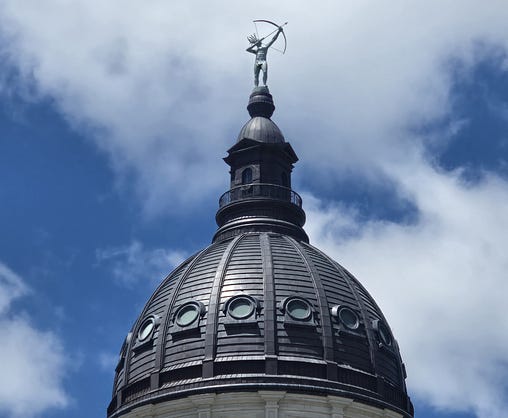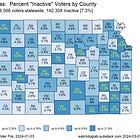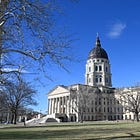A voter’s status can be “active” or “inactive” at their election office but these labels are a bit misleading. “Inactive” voters – there are 140,000 on Kansas voter rolls – cannot be contacted by election offices through the US mail. Their current address is unknown.
Yet these “inactive” voters can vote if they show up.
It’s a mystery why an inactive voter is allowed to vote in any “district” election that is dependent on a voter’s address, when an inactive voter’s address is known to be invalid. Shouldn’t “inactive” voters be required to vote provisionally in any district contest so their district and address can be verified?
“Inactive” voters often do not vote since they have moved. Many “inactives” may be voting in a different state and may not know they are still on the list in Kansas. This is a huge contribution to “bloat” in the voter rolls. The federal process to remove them can be glacially slow.
Kansas had about 7.3% inactive voters at the beginning of the year and that is still the approximate statewide figure.
There is little or no uniformity among the 105 Kansas county clerks and election commissioners in how and when they perform voter list maintenance.
There are huge differences across the state in voter list maintenance as measured by the percentage of inactive voters.
Inactive rates that are too high — or too low — might be an indication that a voter list is not being routinely maintained.
High inactive rates might be an indication that voters are being marked as “inactive” but no list maintenance is occurring to remove them. Low inactive rates might reflect recent maintenance — or possibly no maintenance over long periods of time.
Reductions in Inactive Voters
Five counties reduced the number of inactive voters on their rolls since January 2024 by 1% or more: Hamilton, Rice, Brown, Grant and Pawnee.

Hamilton County’s inactive rate was in the middle “normal” range but improved significantly by 6.6% to be in the “low” range now.
Rice County was in the “high” inactive range and made a significant reduction of 4.6%, but its inactive rate is still the second highest in the state.
Increases in Inactive Voters
Three counties increased the number of inactive voters on their rolls since January 2024 by 1% or more: Riley, Pottawatomie and Lincoln.

State “Inactive” Map
The are no set standards for what is a “low” or “high” inactive rate, so let’s order the 105 counties by their inactive rate into five groups (quintiles):
- Low. The inactive rate in the lowest 21 counties is 2.98% or less. These counties may have just completed list maintenance. There have been cases, however, when low numbers mean no list maintenance is happening!
- Low Normal: The next 21 counties have rates above 2.98% up to 4.46%. Likely good maintenance.
- Normal: The middle 21 counties have rates above 4.46% up to 6.44%. Likely good maintenance.
- High Normal: The fourth quintile ranges from above 6.44% up to 9.08%. Likely good maintenance, but rates are getting high.
- High. The inactive rate is highest in these 21 counties, ranging above 9.08% up to 18.5%. These counties should be asked about the list maintenance. See labels in yellow in the map below.
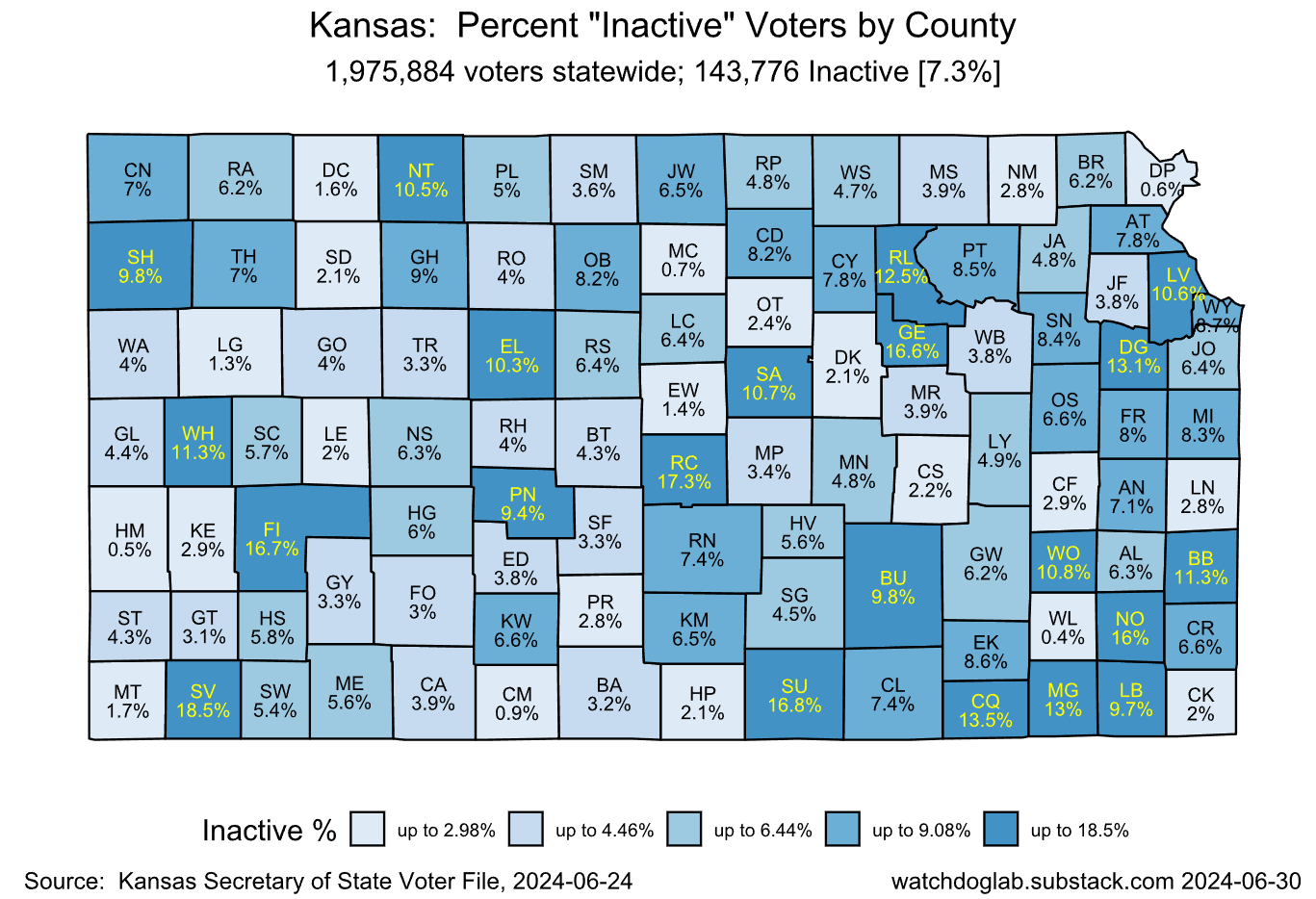
Counties with 10% or higher inactive rate
This list is similar to one published in March with data from January 3, 2024.
The stats below are based on June 24 data from the Secretary of State.
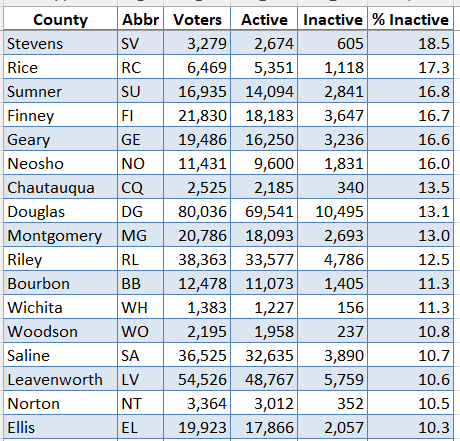
High “inactive” Precincts
Sometimes certain precincts are “hot spots” for high inactive rates that deserve additional scrutiny.
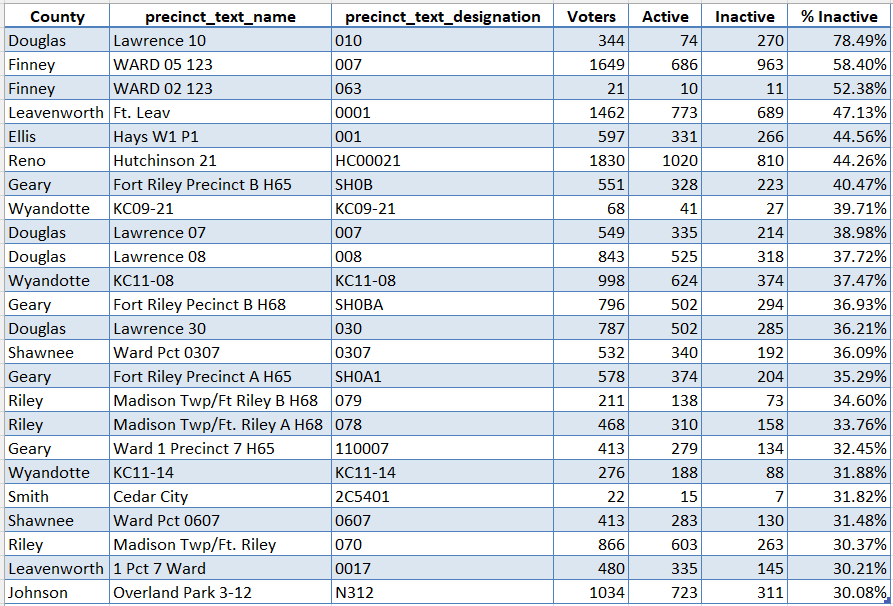
Precincts with high inactive rates often occur in places with transient populations, such as college campuses (KU, K-State) or military bases (Ft. Riley and Ft. Leavenworth).
Better checks and balances are needed to scrutinize voters who do not have known mailing addresses.
Related

Earl Glynn – Watchdog Lab
Earl F. Glynn is a mostly-retired data scientist, scientific programmer, software engineer and physical scientist living in the Kansas City metro area, and the publisher of the substack Watchdog Lab.


